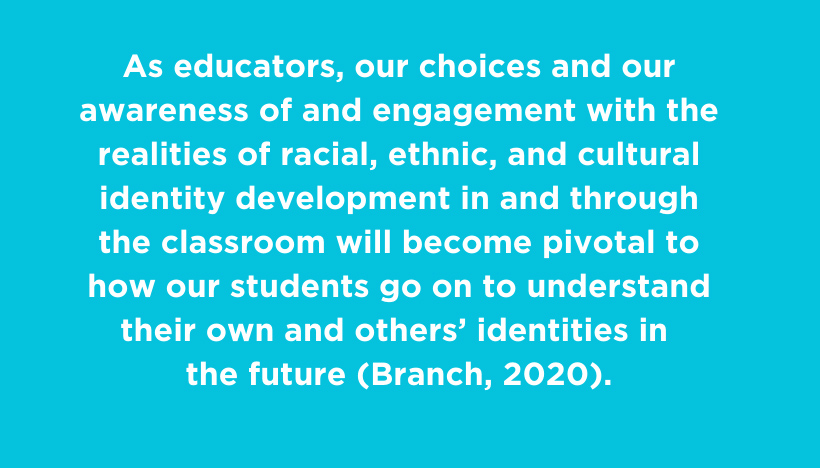This article by NCTE member Michael Domínguez appeared in the December 2021 issue of Voices from the Middle.
As a Chicano educator, I can’t think of ambiguity without thinking about Gloria Anzaldúa, and about the way her words have captured the ambiguity of race, ethnicity, culture, and belonging so profoundly, not just for myself and many other Chicanx and Latinx folks but for our national racial reality more generally.
For while Anzaldúa writes particularly about the mestiza/o character of Latinidad, and the US–Mexico border, if the last several years have taught us anything, it is that we are all living in a tapestry of metaphorical borders defined by our racial and cultural identities.
By some measures, our schools and neighborhoods are, shockingly, more segregated now than before Brown v. Board of Education (Frankenberg, 2019), and recent events have shown us how profoundly divergent our lived experiences of race continue to be. How we choose to cope—personally and in our classrooms—with the ambiguity that exists in these literal and metaphorical racial borderlands has profound implications for our students’ futures.
Whatever our and our students’ racial, ethnic, and cultural identities are, these positionalities and experiences shape how we see and understand the world. For all of us, these realities are something messy, something negotiated, something at least a little ambiguous, because race and ethnicity themselves are ambiguous concepts. Racial identity is at once socially constructed but, at the same time, profoundly real in its consequences. The experience of race is at once defined by our phenotype—but also context. And while we can (and should) identify racism, sexism, etc., as clearly, unambiguously wrong, the reality is that the lived experience of these dimensions of identity is filled with ambiguity, gray areas, microaggressions, unconscious bias, and subtle forms of marginalization far more often than cut-and-dry instances of blatant prejudice. Talking across ambiguous racial borders, we can (and do) interpret the same events, exchanges, and narratives in wildly different ways—ways shaped by how our identities, lived experiences, and racialized histories are positioned in relation to social power and broader cultural realities.
Making sense of all of this for youth (and ourselves) is, surely, messy work. But we do our students no service if we fail to help them embrace the ambiguity of the world, to entertain contradictions, and to critically examine the language and narratives at play when our racial experiences come to the fore—not least because middle school is the most profoundly critical moment to do so. It is, roughly speaking, during the middle grade years that youth begin to perceive the ambiguity of identity, that they begin to notice the social and material significance of belonging, link the racial patterns and messages they have been immersed in since birth to tangible sociopolitical and sociocultural realities, and begin to develop, and cope with, the tension of these realities in their own lives (Tatum, 2017).
As educators, our choices and our awareness of and engagement with the realities of racial, ethnic, and cultural identity development in and through the classroom will become pivotal to how our students go on to understand their own and others’ identities in the future (Branch, 2020). Either our students will come to see the world with subtlety, empathy, and fascination, able to appreciate the nuance and ambiguity of racial experience; or, in fear, silence, and confusion, they will seek to divide the world into Us/Them.
And yet as I write this, some 13 US states have enacted laws that purport to ban the teaching and discussion of race in the classroom as an un-American idea, or “divisive” concept, essentially foreclosing upon the possibility of guiding students as they make sense of these realities. By the time of publication, that number, sadly, may have grown. While these most recent legislative efforts may feel new, we as educators have long been pressured to “depoliticize” our teaching and to avoid discussing topics like race, ethnicity, culture, and other significant elements of identity, precisely because of their ambiguity. Systems and positions of power don’t like ambiguity. Power prefers that we remain stuck in Us/Them thinking—and the status quo it perpetuates.
Ambiguity, on the other hand, invites reflection. Ambiguity asks questions. Ambiguity requires nuance, compromise, and uncomfortable states of dissonance. Ambiguity disrupts the silence in which injustice and oppression thrive. By embracing the ambiguities of race in our classrooms, we open the possibility for connection as we all wade into the uncertain terrain of the racial borderlands together.
Where else but in ELA do we lay the groundwork for nuanced thought and navigating ambiguity? If adolescence is the critical moment of identity we know it to be, our choices have the potential to shape our students’ dispositions in relation to ambiguity; to be open, reflective, curious people who can thrive in the face of contradiction. Reflecting on these big ideas about ambiguity—and race—I’ve presented thus far is critical for all of us, but I do want to make sure I also offer some concrete perspectives on how we might translate an embrace of racial ambiguity to our classroom practice in support of youth.
Ambiguity in Praxis
Too often, we are presented with the idea that conversations around race are conversations about catastrophe, and literature about race is literature about trauma (Domínguez & Domínguez, 2020). But as I’ve noted, race and racial experience are far more mundane and far more ambiguous than this.
So how might we take up discussions or writing around race and sociopolitical issues in our classes? One way is by rejecting the idea of these conversations as “debates.” The entire premise of debate as a rhetorical and literary task is to reject ambiguity, dissonance, and contradiction. It reinforces that one side must be right, and the other wrong. It reduces coexistence to a zero-sum, win or lose game. It reinforces Us/Them thinking, often obscuring the (hopefully obvious fact) that someone else’s existence and identity are not debatable, and leaves us all less human.
What if instead, we structured our rhetorical and argumentative skill development class activities around consensus building, and creative problem solving? What if we began not by taking sides, but by identifying our shared, core premises, then competing needs, and then challenging students not to win the day, but to identify solutions that best serve all the divergent, messy, ambiguous experiences and needs we had considered? Can we imagine being rewarded for our empathy and tolerance of ambiguity, rather than disposing of another’s perspective?
Moreover, there is a wealth of literature available to us in the middle grades that invites us to explore the more ambiguous, nuanced, and mundane ways race, ethnicity, and culture shape our lived experiences.
Bowles’s They Call Me Güero (2018), Yang’s Dragon Hoops (2020), Khorram’s Darius the Great is Not Okay (2017), and Rhodes’s Black Brother, Black Brother (2020), to name a few, invite race into the classroom not as a topic of trauma, but of persistent normality. Texts like these, focused on characters living in ambiguity and contradiction as they process their own identities and daily experiences, can help our students understand and make sense of the subtle, mundane ways that race impacts our lives beyond the headline-grabbing moments and opens up the possibility for us to structure and guide candid conversations on the nuance of race and injustice that, more likely than not, will better reflect our students’ varied developmental trajectories.
To wrap up, I’ll turn once more to Anzaldúa (1987), who reminds us that, “The struggle has always been inner, and is played out in outer terrains. . . . Nothing happens in the ‘real’ world unless it first happens in the images in our heads.”
In this critical moment of middle school when youth are making sense of who they are, the ambiguities and tensions of race, and the state of the sociopolitical world around them, ensuring that we are doing everything we can to encourage them to navigate and embrace ambiguity and imagine a humanizing, antiracist future is the least we can do.
References
Anzaldúa, G. (1987). Borderlands/La frontera: The new mestiza. Aunt Lute Books.
Bowles, D. (2018). They call me Güero: A border kid’s poems. Cinco Puntos Press.
Branch, A. J. (2020). Promoting ethnic identity development while teaching subject matter content: A model of ethnic identity exploration in education. Teaching and Teacher Education, 87.
Domínguez, M., & Domínguez, A. (2020). Playing past racial silence. Study and Scrutiny: Research on Young Adult Literature, 4(2), 1–30.
Frankenberg, E., Ee, J., Ayscue, J. B., & Orfield, G. (2019). Harming our common future: America’s segregated schools 65 years after Brown. The Civil Rights Project-UCLA.
Khorram, A. (2018). Darius the Great is not okay. Dial Books.
Rhodes, J. P. (2020). Black brother Black brother. Little, Brown and Company.
Tatum, B. D. (2017). Why are all the Black kids sitting together in the cafeteria? And other conversations about race. Basic Books.
Yang, G. L. (2020). Dragon hoops. First Second Books.
 Michael Domínguez is an assistant professor of Chicana/o studies at San Diego State University and a former middle school teacher. Always committed to the middle grades, his current projects involve school–community partnerships to support historically marginalized youth and teachers and developing a program model for preparing K–12 educators to teach ethnic studies. He is proud to chair the Middle Level Section Steering Committee.
Michael Domínguez is an assistant professor of Chicana/o studies at San Diego State University and a former middle school teacher. Always committed to the middle grades, his current projects involve school–community partnerships to support historically marginalized youth and teachers and developing a program model for preparing K–12 educators to teach ethnic studies. He is proud to chair the Middle Level Section Steering Committee.
It is the policy of NCTE in all publications, including the Literacy & NCTE blog, to provide a forum for the open discussion of ideas concerning the content and the teaching of English and the language arts. Publicity accorded to any particular point of view does not imply endorsement by the Executive Committee, the Board of Directors, the staff, or the membership at large, except in announcements of policy, where such endorsement is clearly specified.

